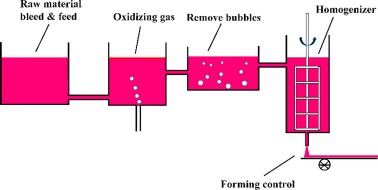Recently, Key Laboratory of Materials for High Power Laser at Shanghai Institute of Optics and Fine Mechanics, Chinese Academy of Sciences, developed a novel kind of lasing phosphate glass with a good luminescent property for high-peak and high-average power. Though adding GeO2 into the glass system, the authors found GeO2 doped phosphate glasses had large gain coefficient and SFL parameters, compared with the traditional phosphate glass. Their findings were published on Materials Science & Engineering B.
The experiments were prepared through the conventional melt-quenching method. The raw materials were first melted in a SiO2 crucible, and the glass liquid was bubbled with O2 for the OH removal. The melt was then transferred to a Pt crucible. After clarifying and stirring process, the glasses were cast into heated steel molds for annealing, then cut and polished to 0.5 mm for the spectroscopic tests, covering density, refractive index, glass transition temperature, absorption and emission spectra.
They observed this novel GeO2 modified Yb: phosphate glass had large fluorescent emission intensity and gain coefficient. The glass transition temperature and density sharply increased with the increasing GeO2 content. Moreover, the Raman spectra demonstrated that the glass network structure could be compact. The series PG glasses had a long lifetime because of the improvement of Yb3+ ions dispersion.
In order to generate pulses with peak powers over 1 PW and intensities beyond 1021 W/cm2, large size laser materials are used in facilities with pulse energy of a few 10’s J or a couple of 100’s J. Phosphate glass is a powerful competitor that possesses such advantages as large size, high quality, bulk supply and low cost. This new laser glass is a competitive gain medium that can be applied to the high-peak power and high-average power for next-generation nuclear fusion.
This work was supported by the National Natural Science Foundation of China (Grants No. 51872308).

Flow chart of glass preparation(Image by SIOM)
Article website:
https://www.sciencedirect.com/science/article/pii/S092151071930025X
Contact:
Mr. Cao Yong
General Administrative Office
Shanghai Institute of Optics and Fine Mechanics, CAS
Email: caoyong@siom.ac.cn







